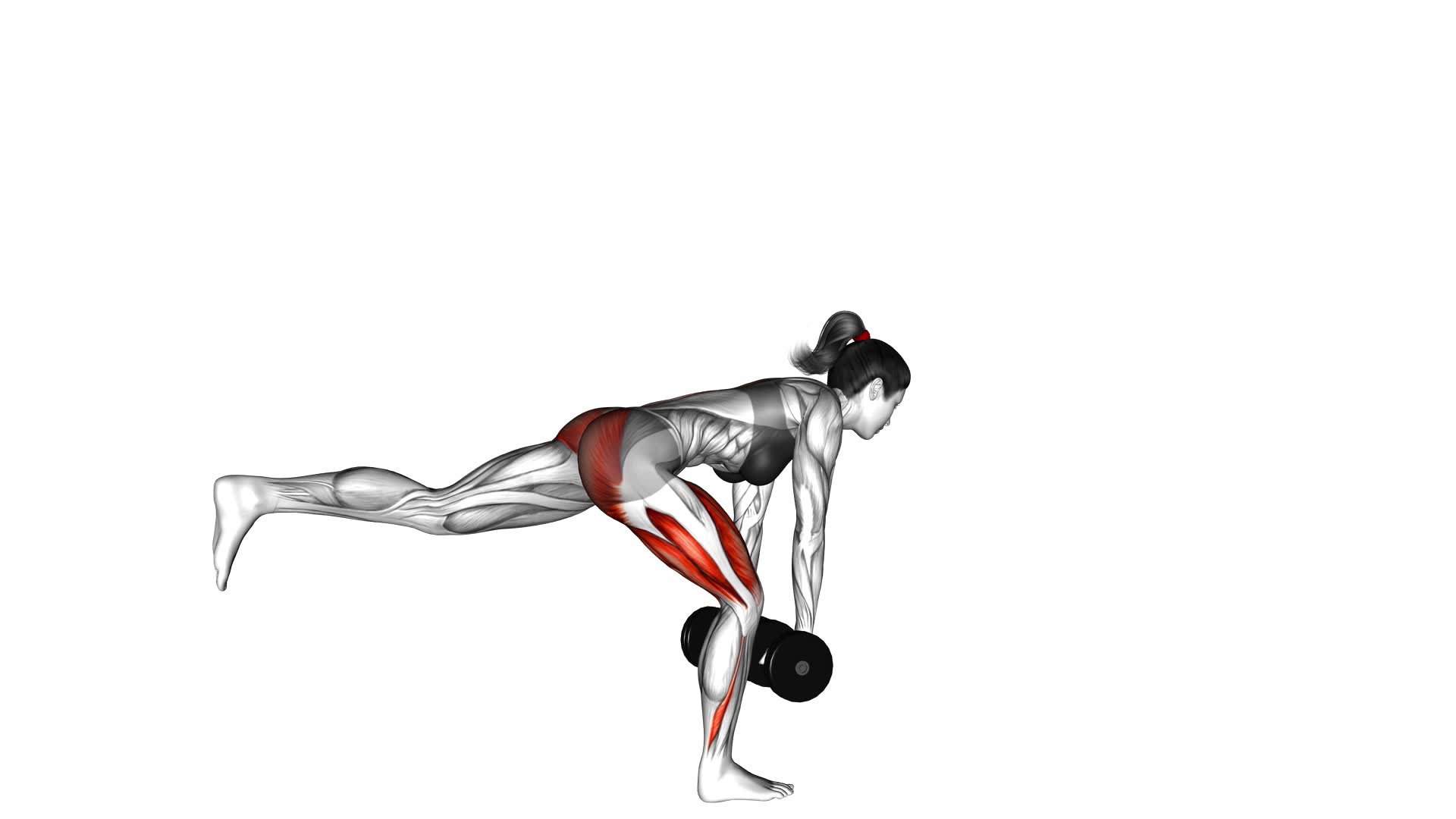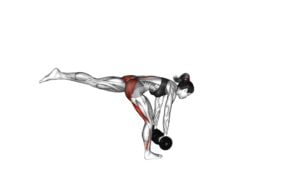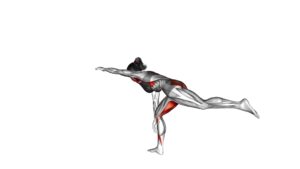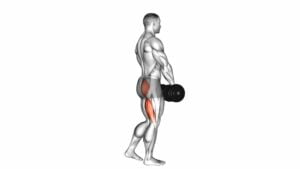Dumbbell Single Leg Deadlift (female) – Video Exercise Guide & Tips

Looking to tone your legs and strengthen your core? The dumbbell single leg deadlift is the perfect exercise for you!
Watch This Exercise Video
In this video exercise guide, we'll show you the proper form and technique, as well as modifications and variations to challenge yourself.
Avoid common mistakes and get tips for incorporating this exercise into your workout routine.
Get ready to level up your fitness game with the dumbbell single leg deadlift!
Key Takeaways
- Strengthens lower body muscles such as glutes, hamstrings, and quadriceps
- Improves balance and stability
- Targets specific muscle groups in the lower body
- Enhances overall fitness level
Benefits of the Dumbbell Single Leg Deadlift
By performing the Dumbbell Single Leg Deadlift, you can strengthen your lower body and improve balance, all while targeting specific muscle groups. The benefits of this exercise are numerous and can have a significant impact on your overall fitness level.
One of the primary benefits of the Dumbbell Single Leg Deadlift is its ability to strengthen your lower body. This exercise specifically targets your glutes, hamstrings, and quadriceps, helping to build strength and definition in these muscle groups. By regularly incorporating this exercise into your routine, you can develop a strong and toned lower body.
In addition to strengthening your muscles, the Dumbbell Single Leg Deadlift also helps improve your balance. By performing this exercise on one leg, you're challenging your stability and forcing your body to engage your core muscles to maintain proper form. Over time, this can lead to improved balance and stability in your everyday activities.
To perform the Dumbbell Single Leg Deadlift correctly, start by holding a dumbbell in one hand, with your feet hip-width apart. Shift your weight onto one leg and hinge forward at the hips, extending your opposite leg behind you. Lower the dumbbell towards the ground while keeping your back straight and your core engaged. Return to the starting position and repeat on the other leg.
Equipment Needed for the Exercise
To perform the Dumbbell Single Leg Deadlift, you'll need a dumbbell and a flat surface. These two simple pieces of equipment are essential for executing this exercise correctly and effectively.
Firstly, you'll need a dumbbell. The weight of the dumbbell will depend on your fitness level and strength. It's recommended to start with a lighter weight and gradually increase as you become more comfortable with the exercise. This will help prevent injury and allow you to focus on maintaining proper form throughout the movement.
Secondly, you'll need a flat surface to perform the Dumbbell Single Leg Deadlift. This can be any stable and secure surface, such as a gym mat or the floor. It's important to choose a surface that provides enough space for you to fully extend your leg while maintaining balance.
In addition to the dumbbell and flat surface, there are no other specific pieces of equipment required for this exercise. However, you may find it helpful to have a mirror nearby to check your form and alignment. Additionally, wearing comfortable workout attire and athletic shoes with good grip can enhance your overall performance and stability during the exercise.
Proper Form and Technique for Performing the Exercise
To perform the Dumbbell Single Leg Deadlift with proper form and technique, maintain a strong core and focus on balancing your weight on one leg. Start by standing with your feet hip-width apart, holding a dumbbell in one hand. Engage your abdominal muscles to stabilize your torso. Shift your weight onto one leg while keeping a slight bend in the knee.
As you hinge forward at the hips, extend the opposite leg straight behind you. Simultaneously, lower the dumbbell towards the ground, maintaining a straight back and a neutral spine. Keep your chest lifted and your shoulders pulled back. Pause when you feel a stretch in your hamstrings, then push through your standing heel to return to the starting position. Repeat the movement on the opposite leg.
When performing the Dumbbell Single Leg Deadlift, it's important to be aware of common mistakes. Avoid rounding your back or allowing your shoulders to roll forward. Instead, keep your spine aligned and your chest open throughout the exercise. Another common mistake isn't engaging the glutes and hamstrings enough during the movement. To maximize the benefits of the exercise, focus on squeezing your glutes and hamstrings as you return to the starting position.
Incorporating the Dumbbell Single Leg Deadlift into your workout routine can help improve balance, stability, and overall lower body strength. It targets the glutes, hamstrings, and lower back, making it a great exercise for athletes and individuals looking to enhance their athletic performance or prevent injuries. Start with a light weight and gradually increase the load as you become more comfortable and confident with the movement. Remember to always prioritize proper form and technique to ensure safety and effectiveness.
Modifications and Variations to Challenge Yourself
To challenge yourself during the Dumbbell Single Leg Deadlift exercise, try adding a balance element by performing it on an unstable surface, such as a BOSU ball or a foam pad. This modification not only targets your hamstrings, glutes, and core muscles but also engages your stabilizing muscles to a greater extent. By introducing an unstable surface, you're forced to engage your core and maintain your balance throughout the movement, making it more challenging and effective.
Another modification you can try is increasing the weight of the dumbbell. As you become stronger and more comfortable with the exercise, gradually increase the resistance to continue challenging your muscles. This progression will help you build strength and improve your stability even further.
Additionally, you can incorporate a plyometric element into the exercise by adding a hop or jump at the top of the movement. This explosive movement won't only test your strength and stability but also enhance your power and athleticism.
By incorporating these modifications and progressions into your Dumbbell Single Leg Deadlift routine, you can continuously challenge yourself and see continued improvements in your strength, stability, and overall fitness.
Now that you know how to modify and challenge yourself during the exercise, let's move on to the next section to learn about common mistakes to avoid.
Common Mistakes to Avoid During the Exercise
To avoid common mistakes during the Dumbbell Single Leg Deadlift exercise, you should focus on maintaining proper form and avoid rushing through the movement. Proper form is crucial to ensure that you engage the correct muscles and avoid potential injuries.
One common mistake to avoid is rounding your back during the exercise. Keeping your back straight and your core engaged will help protect your spine and maintain stability.
Another mistake isn't keeping your standing leg slightly bent. This helps with balance and stability, preventing you from wobbling or falling over.
It's also important to avoid letting your knee collapse inward as you lower the dumbbell. This can put excessive strain on your knee joint. Instead, focus on keeping your knee in line with your toes throughout the movement.
Lastly, make sure to avoid swinging the dumbbell or using momentum to lift it. Instead, concentrate on using the muscles in your glutes and hamstrings to lift your leg and the dumbbell.
Tips for Incorporating the Dumbbell Single Leg Deadlift Into Your Workout Routine
If you're a beginner, there are variations of the dumbbell single leg deadlift that you can start with to build strength and stability.
One benefit of incorporating this exercise into your routine is that it targets multiple muscle groups, including your glutes, hamstrings, and core.
Adding the dumbbell single leg deadlift to your workout routine can help improve your balance, increase your overall strength, and enhance your athletic performance.
Variations for Beginners
Once you have mastered the basic form of the dumbbell single leg deadlift, you can begin incorporating variations into your workout routine.
For beginners, it's important to start with modifications that allow you to build strength and stability before progressing to more challenging exercises.
One beginner modification is to perform the exercise without any weights, focusing on perfecting your form and balance.
Another option is to use a resistance band around your hips for added support. This will help you develop the necessary strength and stability in your glutes and hamstrings.
Additionally, alternative exercises like the single leg glute bridge or the Romanian deadlift can also be incorporated into your routine to target similar muscle groups.
Remember to listen to your body and gradually increase the difficulty of the exercises as you become more comfortable and confident in your abilities.
Benefits of Single Leg Deadlift
To maximize the benefits of the dumbbell single leg deadlift and incorporate it into your workout routine, you should focus on maintaining proper form, gradually increasing the weight, and challenging yourself with different variations.
One of the key benefits of the single leg deadlift is injury prevention. By performing this exercise, you're strengthening the muscles in your lower body, including your glutes, hamstrings, and calves, which can help stabilize your joints and reduce the risk of injuries.
Additionally, the single leg deadlift activates multiple muscles simultaneously, making it a highly effective exercise for muscle activation. It targets not only your lower body but also your core muscles, including your abdominals and lower back.
Frequently Asked Questions
How Many Repetitions Should I Do When Performing the Dumbbell Single Leg Deadlift?
When performing the dumbbell single leg deadlift, it's important to consider how many repetitions to do. This exercise targets several muscles, including the glutes, hamstrings, and lower back.
To determine the number of repetitions, it's best to start with a weight that challenges you but still allows for proper form. Aim for 8-12 repetitions per set, and perform 2-3 sets for a complete workout.
Remember to listen to your body and adjust the intensity as needed.
Can I Use a Kettlebell Instead of a Dumbbell for This Exercise?
Yes, you can definitely use a kettlebell instead of a dumbbell for the exercise. Substituting a kettlebell for a dumbbell can add variety and challenge to your workout routine.
Kettlebell training offers unique benefits such as improved grip strength, increased mobility, and enhanced core stability.
Is It Necessary to Warm up Before Doing the Dumbbell Single Leg Deadlift?
It's important to warm up before doing the dumbbell single leg deadlift. Dynamic warm up exercises help prepare your muscles and joints for the workout, reducing the risk of injury. They also increase blood flow and improve your range of motion.
If you're a beginner, there are modifications you can make to make the exercise easier. Remember to start with lighter weights and gradually increase as you build strength and stability.
Can This Exercise Help Improve My Balance?
Improving your balance is a key benefit of single leg exercises, like the Dumbbell Single Leg Deadlift. By challenging your stability, this exercise helps to strengthen the muscles in your lower body and core.
This can lead to improved balance and coordination in your everyday activities and sports. Incorporating this exercise into your routine can be a great way to target multiple muscle groups and enhance your overall physical performance.
How Often Should I Incorporate the Dumbbell Single Leg Deadlift Into My Workout Routine for Optimal Results?
To get optimal results, incorporate the dumbbell single leg deadlift into your workout routine regularly. This exercise targets multiple muscle groups and improves balance.
To spice things up, try incorporating other variations of the single leg deadlift, like using different equipment or adding a twist.
Single leg exercises have many benefits, such as improving stability, strengthening the core, and preventing muscle imbalances.
Conclusion
Incorporating the dumbbell single leg deadlift into your workout routine can provide numerous benefits. This exercise targets multiple muscle groups, including the glutes, hamstrings, and lower back. By using proper form and technique, you can maximize the effectiveness of this exercise and avoid common mistakes.
The dumbbell single leg deadlift also helps improve balance, core strength, and lower body stability. These benefits are especially important for athletes and individuals looking to enhance their performance in sports or daily activities.
To perform this exercise correctly, start by standing tall with a dumbbell in one hand. Engage your core muscles and lift one leg slightly off the ground, keeping it straight. Hinge forward at the hip, extending the lifted leg backward and lowering the dumbbell towards the ground. Keep your back straight and your supporting leg slightly bent. Return to the starting position by squeezing your glutes and bringing your lifted leg forward. Repeat the movement for the desired number of repetitions, then switch sides.
As with any exercise, it's crucial to start with a weight that challenges you but allows you to maintain proper form. Gradually increase the weight as you become stronger and more comfortable with the movement. You can also try different variations, such as using a kettlebell or performing the exercise on an unstable surface, to continue challenging yourself and progressing in your fitness journey.
Incorporating the dumbbell single leg deadlift into your workout routine is a great way to target multiple muscle groups and improve your balance, core strength, and lower body stability. Start reaping the benefits of this exercise today and take your workouts to the next level.

Author
Years ago, the spark of my life’s passion ignited in my mind the moment I stepped into the local gym for the first time. The inaugural bead of perspiration, the initial endeavor, the very first surge of endorphins, and a sense of pride that washed over me post-workout marked the beginning of my deep-seated interest in strength sports, fitness, and sports nutrition. This very curiosity blossomed rapidly into a profound fascination, propelling me to earn a Master’s degree in Physical Education from the Academy of Physical Education in Krakow, followed by a Sports Manager diploma from the Jagiellonian University. My journey of growth led me to gain more specialized qualifications, such as being a certified personal trainer with a focus on sports dietetics, a lifeguard, and an instructor for wellness and corrective gymnastics. Theoretical knowledge paired seamlessly with practical experience, reinforcing my belief that the transformation of individuals under my guidance was also a reflection of my personal growth. This belief holds true even today. Each day, I strive to push the boundaries and explore new realms. These realms gently elevate me to greater heights. The unique combination of passion for my field and the continuous quest for growth fuels my drive to break new ground.







